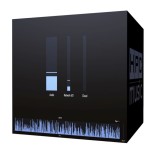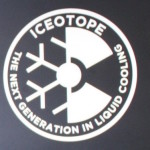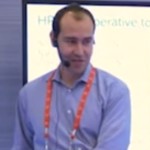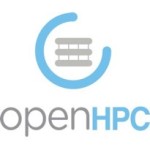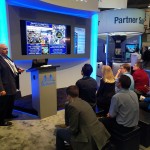Many will be familiar with HPC and industrial or scientific applications, but now HPC is making its impact on something that touches the soul of millions and millions of people every day — music. In an interview with the inventor of HPC for Music, Antonis Karalis shared a brief explanation of how the future of music has been compromised and what steps are being taken to revolutionize music composition, the creative workflow, and deliver new entertainment experiences. Along the way, Karalis is applying cutting edge computing technologies including Intel Optane 3D memory and the Scalable System Framework.
Iceotope Showcases ExaNeSt Cooling Technology for Exascale
In this video from SC15, Peter Hopton from Iceotope describes the company’s innovative liquid cooling technology for the European ExaNeSt project. “ExaNeSt will develop, evaluate, and prototype the physical platform and architectural solution for a unified Communication and Storage Interconnect and the physical rack and environmental structures required to deliver European Exascale Systems.”
Video: Trends and Tech in the HPC Market
In this video from SC15, Dell’s Onur Celebioglu discusses why HPC is now important to a broader group of use cases. He also provides an overview of HPC for research, life sciences and manufacturing. Participants learned more about why HPC, big data and cloud are converging, and how Dell solves challenges in our HPC engineering lab and through collaborative work with other leading technology partners and research institutions.
China’s HPC Vendors Look to US and European Markets
Who are the world’s most important vendors of supercomputers, at least as measured by the number of systems they have in the Top500? HP is the leader with a 31 per cent share; Cray is number two with just under 14 per cent. So far, so unsurprising. But what has been little remarked upon is that in third place – with 49 systems, or 9.8 per cent of the Top500 list – is the Chinese vendor, Sugon. And both Sugon and Inspur, the other main Chinese vendor, have their sights set on expanding still further, with trade missions to Europe and setting up partnerships and subsidiaries in both Europe and the USA.
Video: InfiniBand Trade Association Update
Bill Lee presented this talk at the Mellanox booth at SC15. “The IBTA is responsible for compliance and interoperability testing of commercial products and has successfully added hundreds of products to its Integrators’ List. The IBTA unites the industry through IBTA-sponsored technical events and resources, and actively promotes InfiniBand from a vendor-neutral perspective through online communications, marketing and public relations engagements.”
Piz Kesch: The Making of a GPU-based Weather Forecasting System
Thomas Schulthess from CSCS presented this talk at the Nvidia booth at SC15. “On October 1, 2015 “Piz Kesch”, a Cray CS-Storm system with NVIDIA K80 GPUs became operational at CSCS on behalf of MeteoSwiss. In this talk, we will discuss the hardware-software co-design project behind this most cost and energy efficient system for numerical weather prediction.”
Building A Real-Time, Closed Loop fMRI Data Analysis System for Neuroscience Experiments
Prof. Kai Li from Princeton presented this talk at the Intel HPC Developer Conference at SC15. “Full correlation matrix analysis (FCMA) is an unbiased approach for exhaustively studying interactions among brain regions in functional magnetic resonance imaging (fMRI) data from human participants. In order to answer neuro-scientific questions efficiently, we are developing a closed-loop analysis system with FCMA on a cluster of nodes with Intel Xeon Phi coprocessors. In this talk, we will discuss our current results and future plans.”
Video: SGI Looks to Zero Copy Architecture for HPC and Big Data
In this video from SC15, Dr. Eng Lim Goh from SGI describes how the company is embracing new HPC technology trends such as new memory hierarchies. With the convergence of HPC and Big Data as a growing trend, SGI is envisions a “Zero Copy Architecture” that would bring together a traditional supercomputer with a Big Data analytics machine in a way that would not require users to move their data between systems.
Is HPC Heading Towards Openness, Chaos, or a Split?
“To be successful in high-performance computing (HPC) today, it is no longer enough to sell good hardware: vendors need to develop an ‘ecosystem’ in which other hardware companies use their products and components; in which system administrators are familiar with their processors and architectures; and in which developers are trained and eager to write code both for the efficient use of the system and for end-user applications. No one company, not even Intel or IBM, can achieve all of this by itself anymore.”
Next Generation SDN Driven Systems for Exascale Data Intensive Science
Harvey Newman from CalTech presented this talk at the Mellanox booth at SC15. “We describe activities of the Caltech High Energy Physics team and collaborators, related to the use Software Defined Networking to help achieve fast and efficient data distribution and access. Results from Supercomputing 2014 are presented together with our work on the Advanced Network Services for the Experiments project, and a new project developing a Next Generation Integrated SDN Architecture, as well as our plans for Supercomputing 2015.”

